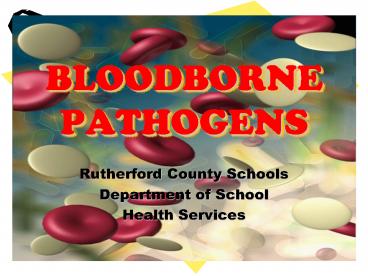BLOODBORNE PATHOGENS - PowerPoint PPT Presentation
1 / 14
Title:
BLOODBORNE PATHOGENS
Description:
Bloodborne Pathogens are germs (microorganisms) that are present in human blood ... Physical education teachers, coaches, and cheerleader sponsors; ... – PowerPoint PPT presentation
Number of Views:2612
Avg rating:3.0/5.0
Title: BLOODBORNE PATHOGENS
1
BLOODBORNE PATHOGENS
- Rutherford County Schools
- Department of School
- Health Services
2
What Are Bloodborne Pathogens?
- Bloodborne Pathogens are germs (microorganisms)
that are present in human blood and can infect
people and cause disease.
3
How are these GERMS spread?
- They are spread by contaminated blood or body
fluids (urine, vomit, mucous, semen, etc.) that
enter the body of another. - Transmission is most likely to occur through
- An accidental cutting of skin by a sharp object,
such as broken glass that is contaminated - Contact between broken or damaged skin and
infected body fluids - Contact between mucous membranes and infected
- body fluids
4
What is Broken Skin?
- Open sores
- Cuts
- Abrasions
- Acne
- Any sort of damaged or broken skin such as
sunburn blisters or by scratching mosquito bites
5
How Else Can it be Spread?
- Through mucous membranes of the eyes, nose, or
mouth - Unprotected sex with an infected person
- Sharing needles with an infected person
6
How is it NOT Spread?
- Through touching an infected person
- Coughing or sneezing
- Using the same equipment, materials, toilets,
water fountains, or showers as an infected person
7
What Can I Do to Protect Myself?
- Use UNIVERSAL PRECAUTIONS (treat everyone as if
they are infected!) - You have gloves available for your use
- Ask your school nurse or the custodian for more
gloves if you are out - Be sure to wash your hands after taking off the
gloves - Appropriate Housekeeping Measures
- Proper disposal of contaminated waste
- Bandages that are NOT dripping blood can be
disposed of in a regular garbage can - MRSA contaminated bandages are highly contagious
- Personal Protective Equipment (PPE)
- Using gloves and/or goggles when appropriate
8
What Could Happen at Work to Put Me At Risk?
- If you dont put your gloves on before dealing
with a child that is vomiting - If you are a First Responder and dont put your
gloves or eye protection on - If there is bleeding and you dont put your
gloves on - If you are changing a diaper and dont wear your
gloves - What else can you think of that may put you at
risk?
9
Complete Your Hepatitis B Series if You Are
Designated At Risk
- Physical education teachers, coaches, and
cheerleader sponsors - School secretaries and/or Para Professionals/Educa
tional Assistants, if they are designated as the
persons who deals with injuries in the normal
performance of their duties - Health Occupation instructors,
- CDC teachers and paraprofessionals working with
developmentally disabled/severely disabled
students - Bus attendants who work with developmentally
- disabled students
- Custodians
- School Principals and their Assistant Principals
- First Responder team members
- Shop teachers, who deal with equipment where
there is a risk of - injury, i.e. wood shop, auto
mechanics, etc. - School Nurses.
10
Response Involving Blood or Body Fluids
- Wear appropriate gloves or goggles
- Carefully cover the spill with an absorbent
material, i.e. paper towel, to prevent splashing - Disinfect with proper solution (custodian will
have the proper equipment) - Wait 10 minutes to ensure adequate
decontamination, and then carefully wipe up the
spilled material - Disinfect all mops and cleaning tools after the
job is done - Dispose of all contaminated materials
appropriately - Wash your hands thoroughly with soap and
water immediately after the clean up is complete
11
Waste Disposal
- Do NOT pick broken glass up directly with your
hands. Instead use items such as a brush and
dustpan to pick it up - Sterilize broken glass that is visibly
contaminated with blood with an approved
disinfectant before cleaning it up - Dispose of decontaminated glass in an appropriate
sharps container. Sharps containers should be
leak-proof on sides and bottom, and appropriately
labeled - Dispose of uncontaminated broken glass in a
closable, puncture resistant container
12
What if I Have an Exposure.
- That results in a cut by a potentially
contaminated needle or other sharp object? - A splash of blood or other potentially infectious
materials to the eyes, mouth, or mucous
membranes? - Blood or other potentially infectious materials
contacting broken skin? - Early treatment can significantly reduce the
chance of disease transmission!
13
When an Employee Has a Possible Exposure
- Clean the area immediately preferably with soap
and water or use alcohol based hand rub - For eyes flush with running water
- Inform the Principal and/or your supervisor as
soon as possible - Complete the First Report of Injury Form
- Complete the Panel of Physicians Form
- You will be seen by the Workmans Comp
physician that you selected on the Panel of - Physicians Form
14
If You Have Any Questions
- Please contact your school nurse
- She is always available to answer your questions































